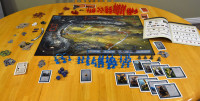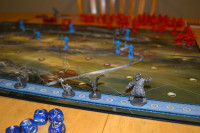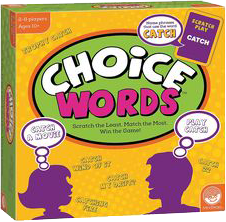6 Tips for Learning a New Board Game
What’s the best way to learn a new board game?
We received this question from a reader last week and realize that plenty of people may have the same question.
I love your review site and I see that you play a ton of games. My question is how do you play so many games? I mean, you got a bunch for Christmas and played through so many of them. I get so bogged down with trying to learn them and read the directions that I almost don’t want any more new games. Do you do all that reading and trying to figure them out or do you have your kids help you? I would appreciate any insight. – Dan.

Dan is right. As reviewers, we’re constantly getting new games to figure out and play. We’ve also played all but 1 of the 11 new board games we got for Christmas.
Over the last 5 years we’ve posted reviews of 250+ board games, cards games, dice games, and party games. Which means we’ve also played a lot more than just those.
And some games definitely take more work to figure out than others.
One of the things I love most about board games is the mental exercise involved in playing them. But I also enjoy learning them.
I like learning new things, solving challenges, and figuring things out.
However, as much as I enjoy the challenge, I also know first-hand how big a chore it can be.
Since we’ve gone through this very exercise many times recently, we’ll share our insight.
Here are 6 Tips to Learning a New Board Game:
To tackle this topic, I first asked my kids their best tip for learning to play a new board game. And guess what they recommend…

“Have your dad teach it to you.”
So much for research.
But their statement is actually spot on.
Most people like having someone else teach them a new game.
However, we can’t all be so lucky. Someone has to forge ahead and take the lead.
And it looks like that person is you.
Since you’re the person reading this, it’s highly likely that you’re the one designated to figure out how to play a new game. So these tips are for you.

1. Learn Before Showtime
The first thing people will want to do when they open a new game is to dive right in and play.
This is especially true for kids. They see shinny, new, fun things and want to play right away.
Who can blame them? It’s hard to be patient when cool things are right before their eyes.
But even with adults, when they open a new game, they’ll want to play right away. They’ll be ready to play as soon as you tell them the rules.
However, if it’s also a new game for you, then you’re out of luck and out of time.
You need to be familiar with the game before play time.
No one wants to just sit around while you shuffle through things trying to figure out how to play.
You need to figure it out before you get on stage.

2. Read the Rulebook
A tip to read the rulebook may seem like a no-brainer. But some people really don’t like to read rulebooks.
And you may be one of those.
Unfortunately, you’ll just have to do it.
Sure there are many things in life that don’t require reading a manual to know how to operate it. But if neither you, nor anyone around you has played a game before, someone will need to read the rules.
It’s also true that not all rulebooks are created equal. Some rulebooks are definitely more confusing than others.
Typically the length of the rulebook will relate to the length and/or depth of the game.

Simple and short games don’t require many rules. Whereas, games with loads of components or game phases will require more space to explain.
Either way, the first thing to look for when opening a rulebook is the Objective. What are players trying to accomplish?
Once you’ve discovered the objective, then read about how the mechanics of the game help the players accomplish it.
And remember – reading the rulebook is something to do on your own ahead of time. There aren’t many things more frustrating than sitting around watching someone read a rulebook. The reader is doing something active. Everyone else will just get bored.
Unless it’s a very simple game with a 1 page rule sheet, don’t fall into the trap when everyone is clamoring to dive right into playing. With simple games with simple rules, sure, dive right in. But for more involved games, read before showtime. (See Tip #1 above.)
3. Watch a Video Run Through
Learning a new game in today’s connected world is only a click away.
If you’d rather skip reading the rules, the next best source is to watch a video review. We’re happy you’re checking out our video reviews, but also know there’s a huge range of board game video reviewers in the world today.
With thousands of new games being published every year, it’s a good thing there are plenty of reviewers you can tap into. We focus on great family board games. But there are also plenty of reviewers that focus on other types of games or more “gamer” games.
Some game publishers also produce their own ‘How to Play’ videos for their games.

Like with the rulebook situation, a video run-through of a simple game can cover the rules fairly quickly. However, for more involved games, a complete rules review will be a lengthy one.
We like to keep our reviews short by just giving a general rules overview so viewers can get a good feel for whether it’s a game their family may like. For simple games we can explain all the rules. But for the average strategy game we typically don’t cover every rule.
Our recent Battlestar Galactica review is a good example. It’s our longest video review at 18 minutes and we still don’t cover every rule in the game.
Video reviews can give you a good overview, and get you on the right track, but you’ll still want to reference the rulebook for most strategy board games.
In fact, for learning most of the new games we got for Christmas, I had already watched a video review. So when I read the rulebooks, I had a better grasp on what the rules were describing. You too may prefer to switch the order of Tips #2 and #3.

4. Set It Up
One of the most helpful ways for me to learn a new board game or card game is through touch.
As science has proven, the more senses we involve in an activity, the more likely we are to remember it. This applies to many things in our life, so why not when learning a new board game as well?
Rather than just reading the rules in isolation, get the components out of the box and set them up.

- Set out the board.
- Open all the shrinkwrap on the cards.
- Punch out all the cardboard tokens.
- Roll the dice.
Then, when you read in the rulebook about a certain deck of cards or a certain token or icon on the board, you can actually inspect it.
Seeing it on the table makes it real.
5. Play Through a Solo Sample Turn
Having the components on the table is great. But game rules are typically about interaction – either with other players or with other game pieces.

Once the game pieces are set out, it’s time to bring the game to life.
Move the pieces around and see first-hand how a game turn progresses.
When the rule says to move the turn marker, draw 5 cards, flip a token, and roll the dice, do just that.
Remember that these are tips for you learning a new game prior to play time. Play this first sample turn solo.
Don’t feel foolish moving game pieces around by yourself. No one is watching.
By playing through an actual game turn, you’re cementing the rules to memory.
The experience of DOING is a great way to learn anything. It’s the same with learning a new board game.
6. Teach It To Others
The way you’ll cement your understanding of new board game is to teach it to others.
As with many things in life, you’ll know you really understand something when you can teach it to others.

It’s not to say you’ll understand all the intricate strategies within the game play yet – those will come while playing – but you will know how play the game.
And don’t worry if you have to refer back to the rulebook while explaining the game to others. Referring back to the rulebook for a point here or there is understandable. Reading the whole rulebook out loud is not.
The rulebooks we love most are those that provide a simple summary on one of the pages. They’re especially helpful when pulling out a game we haven’t played for a long time.
We know the general rules, but some elements like # of cards each player gets or the order of steps on a turn are great to have in cheat sheet/summary form. One glance and our memory is stirred.
There you have it – 6 Tips for learning a new board game.
Give them a shot with the next board game you get for your family (or with the games you got for Christmas that you haven’t dared tackle yet).
Happy Gaming!



Excellent recommendations!
Thanks i realy like tip nr 5.its strange but fun to play the game alone 😉
We’ve found that downloading a PDF of the rules so that one player has the rule book that came with the game and another has it on the iPad simultaneously, helps a lot. Two heads are better than one!
John – that sounds like a great tip as well.
I also carry the rule book PDFs on my smartphone so I can review them whenever I get some downtime or get stuck waiting somewhere. Sometimes even a few minutes looking at a specific section of a rule book that is confusing can really help.
Most publishers upload the game manuals and even variant rules and updates on their official website, and I like to download and read them as soon as I order the game, and start watching ru throughs and reviews… when it arrives I have a pretty good grasp of the basic stuff to start playin with the family.
The rules forums on BGG or other gaming sites are also a good read, as they discuss potential rules misunderstandings or other unclear stuff in the manual, and if it’s something that happens to a lot of people, sooner or later it will happen to you, so be prepared.
For more complex games I tell them to be a little patient and spend a couple of hours doing a solo run, because there can be a lot of weird rules and special situations that can happen, and at least you can be prepared to solve a coupleof them (or at least you know more or less where to look for the answers quickly).
Mauricio – I agree that the Rules forums on BGG are a great source to clarify our understanding of game rules. We’ve been known to turn to that source in a few games where the rules as written weren’t as clear.
Eminant domain I found much easyer to grasp watching the how to play vs the rulebook
I agree with all that happened in the video that made me have a better understanding to teach a game better and how to make everyone understand them and don’t miss the small steps that you think everyone should just know.